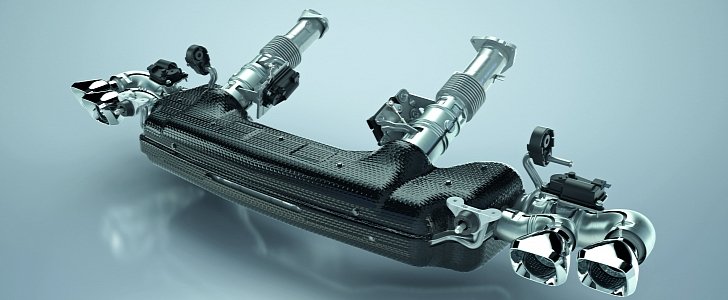Designing the all-new Corvette wasn’t as straightforward as you might imagine. Switching from the front-engine design of the C7 to the mid-engine setup of the C8 presented a number of challenges for General Motors, more so if you remember how little experience the American automaker has with this kind of layout.
Before the eighth-generation ‘Vette came to be, there was Need for Speed: Hot Pursuit. One of the cars you could play in the game is the Opel Speedster, also known as the Vauxhall VX220 in the United Kingdom. Underpinned by a vehicle architecture from Lotus, the Speedster and VX220 were the first mid-engine cars developed by General Motors after the P-body Pontiac Fiero from the ‘80s.
Having said that, even the exhaust system of a mid-engine sports car presents different challenges compared to the exhaust system of a front-wheel-drive automobile. For the C8, a company called Tenneco has been chosen as the supplier of “the complete cold-end exhaust system” and a range of other components.
“The mid-engine architecture required creative technical solutions to accommodate the packaging and thermal requirements of the emissions system,” declared Patrick Guo, executive vice president of Tenneco. “We partnered with GM, combining our experience in system integration with the Corvette’s engineering team to deliver technologies that help to enable a more efficient, high-performance vehicle.”
C8 models without the Z51 Performance Package come with the standard exhaust system, featuring two valves that are designed to work together with the Active Fuel Management system. These valves can also vary the volume of the exhaust sound as the driver switches between the two engine modes of the non-Z51 Stingray.
As for the Stingray with the $5,000 performance package, the Z51 boasts four electronic valves – promising even more of a ruckus. The decoupled design of the valves is meant to reduce the heat impact on the electronics, and speaking of which, Tenneco is proud of the multi-layer head shields of the exhaust system.
Last, but certainly not least, the non-Z51 and Z51 exhaust systems are built locally at the Tenneco Clean Air manufacturing facility in Smithville, Tennessee. The supplier is also responsible for a few parts that go into the LT2 small-block V8 with up to 495 horsepower on deck. These components include the 6.2-liter engine’s bearings, bushings, valve seats, valve guides, pistons, and piston rings.
Having said that, even the exhaust system of a mid-engine sports car presents different challenges compared to the exhaust system of a front-wheel-drive automobile. For the C8, a company called Tenneco has been chosen as the supplier of “the complete cold-end exhaust system” and a range of other components.
“The mid-engine architecture required creative technical solutions to accommodate the packaging and thermal requirements of the emissions system,” declared Patrick Guo, executive vice president of Tenneco. “We partnered with GM, combining our experience in system integration with the Corvette’s engineering team to deliver technologies that help to enable a more efficient, high-performance vehicle.”
C8 models without the Z51 Performance Package come with the standard exhaust system, featuring two valves that are designed to work together with the Active Fuel Management system. These valves can also vary the volume of the exhaust sound as the driver switches between the two engine modes of the non-Z51 Stingray.
As for the Stingray with the $5,000 performance package, the Z51 boasts four electronic valves – promising even more of a ruckus. The decoupled design of the valves is meant to reduce the heat impact on the electronics, and speaking of which, Tenneco is proud of the multi-layer head shields of the exhaust system.
Last, but certainly not least, the non-Z51 and Z51 exhaust systems are built locally at the Tenneco Clean Air manufacturing facility in Smithville, Tennessee. The supplier is also responsible for a few parts that go into the LT2 small-block V8 with up to 495 horsepower on deck. These components include the 6.2-liter engine’s bearings, bushings, valve seats, valve guides, pistons, and piston rings.























